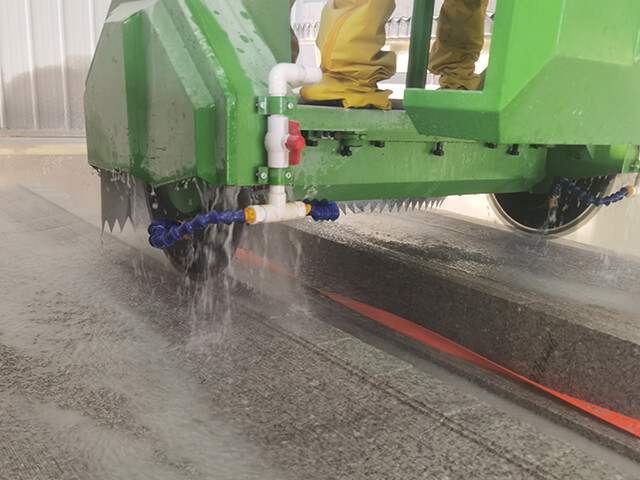Author:Dafon Kerbstone Machine FROM:Stone Machine Manufacturer TIME:2024-08-21
A profile cutting machine is used to cut and shape various profiles or contours into materials such as stone, metal, or wood. In the context of stone manufacturing, a stone profile cutting machine is specifically designed to create detailed shapes and intricate designs on stone surfaces. This machine is commonly used in the production of architectural elements like countertops, edges, columns, moldings, and decorative stonework.
The key uses of a profile cutting machine include:
Custom Edge Profiling: It shapes the edges of stone slabs into various profiles, such as bullnose, ogee, or bevel, enhancing the aesthetic appeal of countertops, steps, and other stone products.
Intricate Design Cutting: It can produce complex designs and patterns on stone surfaces, which are used in architectural decoration, monuments, and customized stone products.
Precision and Efficiency: The machine ensures high precision and consistency in cutting, which is essential for producing high-quality stone products with intricate details.
Versatility: Profile cutting machines can work with a variety of stone materials, including granite, marble, and quartz, making them versatile tools in the stone fabrication industry.
Overall, a profile cutting machine is essential for adding value to stone products by enabling the creation of custom shapes and designs with high accuracy and efficiency.
Different machines can be used for cutting various profiles depending on the material and the specific profile needed. In the stone industry, the primary machines used for cutting different profiles include:
CNC Stone Profile Cutting Machines:
These are computer-controlled machines that can cut intricate and complex profiles on stone slabs. CNC machines are highly versatile and can produce consistent and precise cuts, making them ideal for detailed edge profiling, curves, and custom shapes.
Stone Profiling Routers:
These machines are designed to cut and shape edges of stone slabs into various profiles. They are often used for creating decorative edges on countertops, stairs, and other architectural elements. Stone routers are usually equipped with diamond-tipped tools that can handle the hardness of stone materials like granite and marble.
Bridge Saws:
Bridge saws, particularly those with advanced features, can be equipped with profiling tools that allow them to cut specific profiles on stone slabs. These machines are typically used for straight and angled cuts but can also perform simple edge profiling.
Waterjet Cutting Machines:
High-pressure waterjet cutting machines can be used to create complex profiles in a wide range of materials, including stone. The 5-axis waterjet cutting machines, in particular, are capable of making intricate cuts and profiles with high precision.
Automatic Edge Profiling Machines:
These machines are specifically designed for shaping the edges of stone slabs. They are typically used in high-volume production environments where consistent and precise edge profiles are required.
Each of these machines is used based on the type of stone, the complexity of the profile, and the production requirements.

The process of profile cutting involves shaping and cutting materials, such as stone, into specific profiles or contours. This process is widely used in the stone fabrication industry to create decorative edges, custom shapes, and intricate designs on stone surfaces. Here's a step-by-step overview of the profile cutting process:
1. Material Selection and Preparation:
Material Selection: Choose the appropriate stone slab (e.g., granite, marble, or quartz) based on the desired end product.
Surface Preparation: Ensure the stone slab is properly prepared, clean, and free from any defects or irregularities. This may involve initial surface grinding or flattening.
2. Design and Profiling Selection:
Design Creation: Use CAD (Computer-Aided Design) software to create a digital model of the desired profile. This includes defining the shape, depth, and complexity of the profile.
Tool Path Programming: For CNC machines, the design is converted into a tool path, which guides the machine’s cutting tool to follow the desired profile.
3. Machine Setup:
Machine Calibration: Set up the profile cutting machine, ensuring it is calibrated correctly according to the material thickness and the complexity of the profile.
Tool Selection: Install the appropriate cutting tools or bits, such as diamond-tipped routers or saw blades, depending on the material and the profile being cut.
4. Cutting Process:
Automated Cutting: For CNC or automatic machines, the cutting process is initiated by running the programmed tool path. The machine precisely follows the design to cut the profile into the stone.
Manual or Semi-Automated Cutting: For less automated machines, the operator may guide the tool along the stone surface, following the design manually or with some level of automation.
5. Inspection and Finishing:
Quality Inspection: Once the profile cutting is complete, the stone is inspected for accuracy and quality. Any irregularities or defects are identified and corrected.
Finishing Touches: The cut profiles may require additional finishing processes, such as polishing or honing, to achieve the desired surface smoothness and shine.
6. Final Product Preparation:
Edge Polishing: If necessary, the edges of the stone are polished to enhance their appearance and ensure they are smooth to the touch.
Final Assembly: The profiled stone pieces are cleaned and assembled as part of the final product, such as a countertop, stair tread, or decorative element.
Summary:
The profile cutting process is a precise and methodical approach that involves selecting and preparing the material, designing the desired profile, setting up the cutting machine, and executing the cut with careful attention to detail. Advanced technologies like CNC machines enable high accuracy and consistency, making the process efficient for both simple and complex profiles.